Neuroscience
Neurons communicate with each other, effector organs and sensory organs through the neurotransmitter – receptor pathway at synapses. Neurotransmitters can be divided into 4 major groups: 1. Amino acids (glumate, aspartate, serine, glycine and GABA); 2. Monoamines (norepinephrine, epinephrine, dopamine, histamine, and serotonin); 3. Peptides (opioid peptides, substance P, somatostatin); and 4. Others (acetylcholine, NO, nucleosides).
Products for Neuroscience
- AChR(52)
- Histamine Receptor(89)
- Dopamine Receptor(114)
- Histamine(3)
- AChE(3)
- SSRIs(8)
- P2X7 receptor(4)
- 5-HT Receptor(238)
- Nicotinic Receptor(61)
- Amyloid β(20)
- Muscarinic Receptor(38)
- Alzheimer(3)
- COX(44)
- GluR(115)
- Neuroscience Peptides(10)
- Substance P/NK1 Receptor(21)
- P2 Receptor(2)
- BACE(3)
- Gap Junction(8)
- CGRP(3)
- DAPK(1)
- GABA Receptor(103)
- NMDA(1)
- mPEGS-1(1)
- Cat.No. Product Name Information
-
BCC6016
CP 99994 dihydrochloride

-
BCC6793
Iodophenpropit dihydrobromide
Iodophenpropit dihydrobromide is a potent and selective histamine H3 receptor antagonist. The binding of [125I]Iodophenpropit is selective, saturable, readily reversible, and of high affinity (KD 0.32 nM).

-
BCC3852
Rizatriptan Benzoate
Rizatriptan Benzoate(Maxalt) is a 5-HT1 agonist triptan drug for the treatment of migraine headaches.

-
BCC6781
Clobenpropit dihydrobromide
Clobenpropit dihydrobromide is a potent histamine H3R antagonist/inverse agonist with a pEC50 of 8.07 for histamine H3LR. Clobenpropit dihydrobromide acts as partial agonist at histamine H4 receptors (Ki 13 nM). Clobenpropit dihydrobromide also binds to serotonin 5-HT3 receptors (Ki 7.4 nM) and α2A/α2C adrenoceptors (Ki 17.4/7.8 nM). Clobenpropit dihydrobromide increases apoptosis.

-
BCC7159
A 77636 hydrochloride
Potent, selective D1-like agonist. Orally active

-
BCC6610
(RS)-MCPG
(RS)-MCPG (alpha-MCPG) is a competitive and selective group I/group II metabotropic glutamate receptor (mGluR) antagonist. (RS)-MCPG blocks theta-burst stimulation (TBS)-induced shifts in both juvenile and neonatal rat hippocampal neurons.
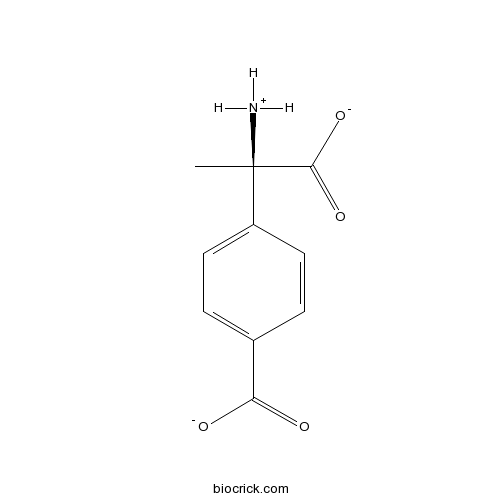
-
BCC2071
Ziprasidone
Ziprasidone (CP-88059) is a combined 5-HT (serotonin) and dopamine receptor antagonist. Ziprasidone exhibits potent effects of antipsychotic activity, and is used for treating various mental disorders including schizophrenia.

-
BCC5260
Alcaftadine
Alcaftadine(R89674) is a H1 histamine receptor antagonist, which is used to prevent eye irritation brought on by allergic conjunctivitis.

-
BCC1728
Maropitant
Maropitant is a neurokinin (NK1) receptor antagonist.

-
BCC6628
Arecaidine propargyl ester tosylate

-
BCC6946
Telenzepine dihydrochloride

-
BCC5691
DCG IV
DCG-IV is a potent agonist of group II mGluRs with EC50s of 0.35 and 0.09 μM for mGlu2R and mGlu3R, reapectively. DCG-IV is also a competitive antagonist at group I (IC50: mGlu1/5R=389/630 μM) and III receptors (IC50: mGlu4/6/7/8R= 22.5/39.6/40.1/32 μM). DCG-IV has anticonvulsive and neuroprotective effects.

-
BCC6750
(±)-Epibatidine
(±)-Epibatidine is a nicotinic agonist. (±)-Epibatidine is a neuronal nAChR agonist.
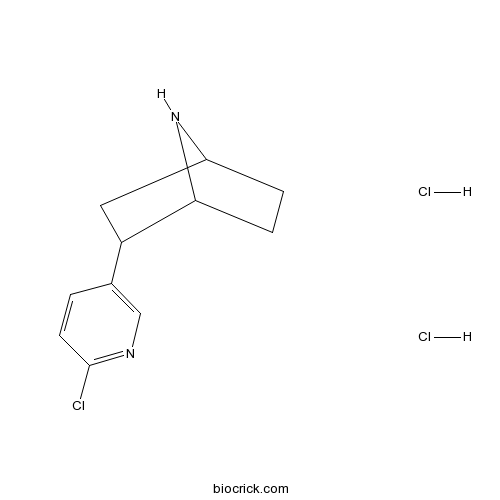
-
BCC6821
L-732,138
L-732138 is a selective, potent and competitive neurokinin-1 (NK-1) receptor antagonist with an IC50 of 2.3 nM. L-732138 has 200-fold more potent in cloned human NK-1 receptors than cloned rat NK-1 receptors, and has > 1000-fold more potent than human NK-2 and NK-3 receptors. L-732138 can reduce hyperalgesia and has antitumor action.

-
BCC5707
L-733,060 hydrochloride

-
BCC6993
(S)-WAY 100135 dihydrochloride
Potent, selective 5-HT1A antagonist

-
BCC7197
Impentamine dihydrobromide

-
BCC4528
Clemastine Fumarate
Clemastine (fumarate) (HS-592 (fumarate)) is a selective histamine H1 receptor antagonist with IC50 of 3 nM.

-
BCC6611
(S)-MCPG
(S)-MCPG is the active isomer of (RS)-MCPG (Cat.

-
BCC1089
Prasugrel
Prasugrel (PCR 4099), a thienopyridine and prodrug, inhibits platelet function. Prasugrel is an orally active and potent P2Y12 receptor antagonist, and inhibits ADP-induced platelet aggregation.

-
BCC5599
Gap19
Gap19, a peptide derived from nine amino acids of the Cx43 cytoplasmic loop (CL), is a potent and selective connexin 43 (Cx43) hemichannel blocker. Gap19 inhibits hemichannels caused by preventing intramolecular interactions of the C-terminus (CT) with the CL. Gap19 is not blocking GJ channels or Cx40/pannexin-1 hemichannels. Gap19 has protective effects against myocardial.

-
BCC4149
Oxybutynin chloride
Oxybutynin chloride is an anticholinergic agent, which inhibits vascular Kv channels in a concentration-dependent manner, with an IC50 of 11.51 μM.

-
BCC4574
Tropicamide
Tropicamide is an anticholinergic and a muscarinic receptor subtype M4-preferring antagonist .

-
BCC5559
Nitenpyram
Nitenpyram is a calss of neonicotinoid and an insect nicotinic acetylcholine receptor (nAChR) agonist with an IC50 of 14 nM. Nitenpyram is an oral fast-acting insecticide used to suppress sucking insects on companion animals.

-
BCC4251
Haloperidol hydrochloride
Haloperidol hydrochloride is a potent dopamine D2 receptor antagonist, widely used as an antipsychotic.

-
BCC7357
GT 2016

-
BCC1026
Amyloid β-Peptide (10-20) (human)
Amyloid β-Protein (10-20) is a fragment of Amyloid-β peptide, maybe used in the research of neurological disease.

-
BCC6098
SR 140333

-
BCC4439
Diclofenac Sodium
Diclofenac Sodium (GP 45840) is a potent and nonselective anti-inflammatory agent, acts as a COX inhibitor, with IC50s of 4 and 1.3 nM for human COX-1 and COX-2 in CHO cells, and 5.1 and 0.84 μM for ovine COX-1 and COX-2, respectively. Diclofenac Sodium induces apoptosis of neural stem cells (NSCs) via the activation of the caspase cascade.

-
BCC5249
Diclofenac
Diclofenac is a potent and nonselective anti-inflammatory agent, acts as a COX inhibitor, with IC50s of 4 and 1.3 nM for human COX-1 and COX-2 in CHO cells, and 5.1 and 0.84 μM for ovine COX-1 and COX-2, respectively. Diclofenac induces apoptosis of neural stem cells (NSCs) via the activation of the caspase cascade.

-
BCC7130
DFB

-
BCC4542
Fexofenadine HCl
Fexofenadine hydrochloride (MDL-16455 hydrochloride), a H1R antagonist, is an anti-allergic agent used in seasonal allergic rhinitis and chronic idiopathic urticarial (person aged ≥16 years).

-
BCC1471
Cevimeline hydrochloride hemihydrate
Cevimeline hydrochloride hemihydrate (SNI-2011) is a quinuclidine derivative of acetylcholine and a selective and orally active muscarinic M1 and M3 receptor agonist. Cevimeline hydrochloride hemihydrate stimulates secretion by the salivary glands and can be used as a sialogogue for xerostomia. Cevimeline hydrochloride hemihydrate can cross the blood-brain barrier (BBB).

-
BCC4523
Tripelennamine HCl
Tripelennamine hydrochloride, a H1-receptor antagonist, is a psychoactive drug and member of the pyridine andethylenediamine classes that is used as an antipruritic and first-generation antihistamine.

-
BCC7301
DMAB-anabaseine dihydrochloride

-
BCC4577
Methscopolamine
Methscopolamine (Pamine) is a muscarinic acetylcholine receptor blocker.

-
BCC4578
Pancuronium dibromide
Pancuronium Dibromide is a bis-quaternary steroid that is a competitive nicotinic antagonist.

-
BCC5060
VUF 10166
VUF10166 is a novel, potent and competitive antagonist for 5-HT3A receptor with Ki of 0.04 nM, its affinity at 5-HT3AB receptor is significantly lower.

-
BCC4215
Pizotifen
Pizotifen (BC-105) is a potent 5-HT2 receptor antagonist, with a high affinity for 5-HT1C binding site.

-
BCC1901
RJR-2403
Rivanicline (RJR-2403; (E)-Metanicotine) is a neuronal nicotinic receptor agonist, showing high selectivity for the α4β2 subtype (Ki=26 nM); > 1,000 fold selectivity than α7 receptors(Ki= 36000 nM).

-
BCC7948
GTS 21 dihydrochloride
GTS-21 dihydrochloride is a selective α7 nicotinic acetylcholine receptor agonist, has recently been established as a promising treatment for inflammation.
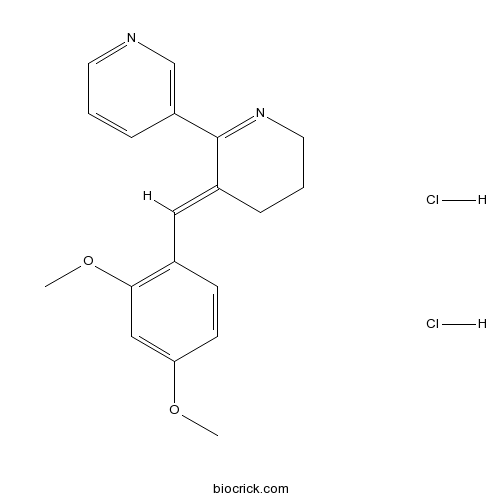
-
BCC5974
α-Conotoxin ImI

-
BCC6835
(RS)-(±)-Sulpiride
Sulpiride is a D2 receptor a antagonist, an atypical antipsychotic drug of the benzamide class, used mainly in the treatment of psychosis associated with schizophrenia and major depressive disorder, and sometimes used in low dosage to treat anxiety and mild depression.

-
BCC3791
Ibuprofen
Ibuprofen is an anti-inflammatory inhibitor targeting COX-1 and COX-2 with IC50s of 13 μM and 370 μM, respectively.

-
BCC4432
Licofelone
Licofelone (ML-3000) is a dual COX/5-lipoxygenase (5-LOX) inhibitor (IC50=0.21/0.18 μM, respectively) for the treatment of osteoarthritis. Licofelone exerts anti-inflammatory and anti-proliferative effects. Licofelone induces apoptosis, and decreases the production of proinflammatory leukotrienes and prostaglandins.

-
BCC7424
OSU 6162 hydrochloride

-
BCC6758
MAP4

-
BCC6839
5-Nonyloxytryptamine oxalate

-
BCC5681
Dihydrexidine hydrochloride
(+)-Dihydrexidine hydrochloride ((+)-DAR-0100 hydrochloride) is a dopamine D1 receptor agonist with an EC50 of 72± 21 nM.

-
BCC6854
MM 77 dihydrochloride

-
BCC7400
L-BMAA hydrochloride

-
BCC4437
Rofecoxib
Rofecoxib is a potent, specific and orally active COX-2 inhibitor, with IC50s of 26 and 18 nM for human COX-2 in human osteosarcoma cells and Chinese hamster ovary cells, with a 1000-fold selectivity for COX-2 over human COX-1 (IC50 > 50 μM in U937 cells and > 15 μM in Chinese hamster ovary cells).

-
BCC6941
GR 103691
GR 103691 is a potent, selective dopamine D3 receptor antagonist with a Ki value of 0.4 nM. GR 103691 shows more than 100-fold selectivity for human dopamine human (h)D3 over hD4 and hD1 sites.

-
BCC2053
WAY-100635
WAY-100635 is a potent and selective 5-HT1A Receptor antagonist with a pIC50 of 8.87, an apparent pA2 of 9.71. WAY-100635 is a potent and selective 5-hydroxytryptamine 1A (5-HT1A) receptor antagonist with an IC50 value of 0.91 nM and Ki value of 0.39 nM. WAY-100635 has pIC50 values for 5-HT1A and α1-adrenergic receptors of 8.9 and 6.6, respectively. WAY-100635 is also a potent dopamine D4 receptor agonist.

-
BCC5049
IEM 1754 dihydrobroMide
IEM 1754 2HBr is a selective AMPA/kainate receptor blockers for GluR1 and GluR3 with IC50 of 6 μM.

-
BCC6802
(S)-3,5-DHPG

-
BCC2041
Vilazodone Hydrochloride
Vilazodone Hydrochloride (EMD 68843 Hydrochloride) is a serotonin transporter (SER) inhibitor and 5-HT1A receptor partial agonist.

-
BCC2040
Vilazodone
Vilazodone (EMD 68843; SB 659746A) is a combined serotonin specific reuptake inhibitor (SSRI) and 5-HT1A receptor partial agonist currently under clinical evaluation for the treatment of major depression.

-
BCC6853
Immepip dihydrobromide

-
BCC6434
ML352

-
BCC6701
Nα-Methylhistamine dihydrochloride
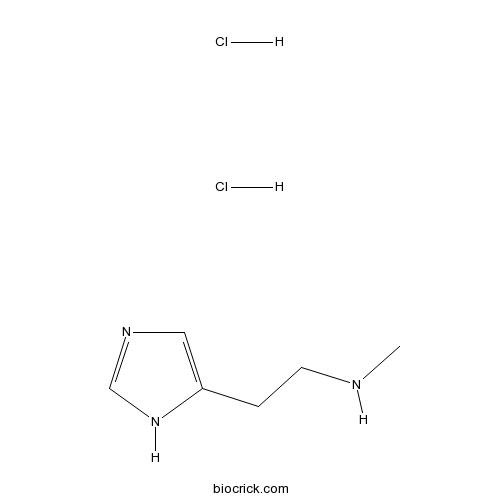
-
BCN2599
L-Stepholidine
L-Stepholidine (Stepholidine), an alkaloid extract of the Chinese herb Stephania intermedia, is the first compound known to exhibit mixed dopamine D1 receptor agonist/

-
BCC6841
AIDA

-
BCC6969
(2R,4R)-APDC
(2R,4R)-APDC is a selective group II metabotropic glutamate receptors (mGluRs) agonist. (2R,4R)-APDC has anticonvulsant and neuroprotective effects.

-
BCC6819
MSPG

-
BCC6820
MTPG

-
BCC4108
Deracoxib
Deracoxib, a selective cyclooxygenase-2 inhibitor, is a non-narcotic, non-steroidal anti-inflammatory drug (NSAID).

-
BCC1099
Celecoxib
Celecoxib is a selective COX-2 inhibitor with an IC50 of 40 nM.

-
BCC5979
α-Conotoxin EI

-
BCC1101
Aprepitant
Aprepitant (MK-0869) is a selective and high-affinity neurokinin 1 receptor antagonist with a Kd of 86 pM.

-
BCC6910
CHPG
CHPG is a selective mGluR5 agonist, and attenuates SO2-induced oxidative stress and inflammation through TSG-6/NF-κB pathway in BV2 microglial cells. CHPG protects against traumatic brain injury (TBI) in vitro and in vivo by activation of the ERK and Akt signaling pathways.

-
BCC6888
E4CPG
E4CPG is a novel group I/group II metabotropic glutamate receptor antagonist, more potent than (RS)-MCPG .

-
BCC6925
(RS)-APICA
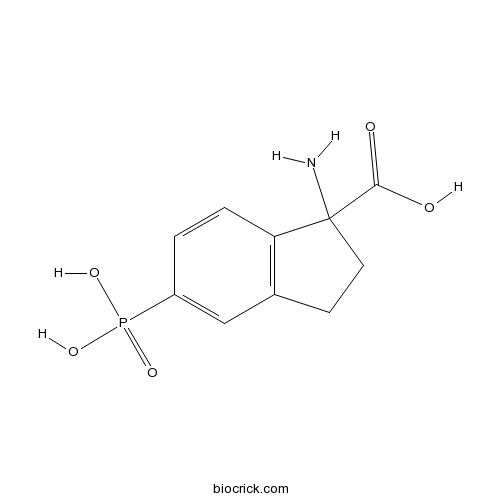
-
BCC7467
PNU 96415E

-
BCC7879
Sonepiprazole

-
BCC6871
EGLU
EGLU ((2S)-α-Ethylglutamic acid; (2S)-α-EGLU) is a potent and competitive mGluR-2 receptor antagonist. EGLU interacts with (lS,3S)-ACPD-sensitive site with a Kd value of 66 μM. EGLU is an antidepressant agent.

-
BCC4281
Fosaprepitant
Fosaprepitant (L-758298) is a neurokinin-1 receptor antagonist for the prevention of chemotherapy-induced nausea and vomiting.

-
BCC5036
Clomipramine HCl
Clomipramine hydrochloride is a serotonin transporter (SERT), norepinephrine transporter (NET) and dopamine transporter (DAT) blocker with Ki of 0.14, 54 and 3 nM, respectively.

-
BCC6814
Oxotremorine sesquifumarate

-
BCC5743
α-Conotoxin MII

-
BCC7614
LY 354740
Eglumegad (LY354740) is a highly potent and selective group II (mGlu2/3) receptor agonist with IC50s of 5 and 24 nM on transfected human mGlu2 and mGlu3 receptors, respectively.

-
BCC7045
(RS)-3,4-DCPG

-
BCC4887
Ambrisentan
Ambrisentan is a selective ET type A receptor (ETAR) antagonist.

-
BCC1802
NKP608
NKP608 is a non-peptidic derivative of 4-aminopiperidine which acts as a selective, specific and potent antagonist at the neurokinin-1 (NK-1) receptor both in vitro(IC50=2.6 nM) and in vivo.

-
BCC7378
Proxyfan oxalate

-
BCC5039
Eletriptan HBr
Eletriptan HBr is a selective 5-HT1B and 5-HT1D receptor agonist with Ki of 0.92 nM and 3.14 nM, respectively.

-
BCC7827
AR-R 17779 hydrochloride

-
BCC7636
NGD 94-1

-
BCC6896
CPCCOEt

-
BCC6895
PHCCC
PHCCC is a Group I metabotropic glutamate receptor antagonist with EC 50 of 6 uM and a positive allosteric modulator of mGluR4. Also as a potent to antagonism for mGluR2 and mGluR8.

-
BCC4112
Sumanirole maleate
Sumanirole maleate (U-95666E; PNU-95666E) is a highly selective D2 receptor full agonist with an ED50 of about 46 nM. Sumanirole was developed for the treatment of Parkinson's disease and restless leg syndrome.

-
BCC5055
Prucalopride
Prucalopride (R093877) is a drug acting as a selective, high affinity 5-HT4 receptor agonist(pKi=8.6/8.1 for 5-HT4a/4b); >150-fold higher affinity for 5-HT4 receptors than for other receptors.
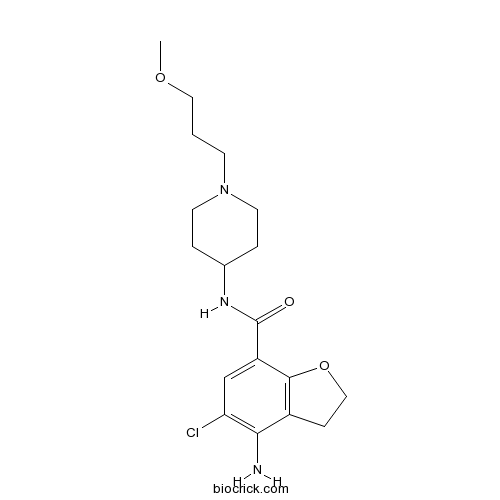
-
BCC7349
SDZ NKT 343

-
BCC5193
Solifenacin hydrochloride
Solifenacin hydrochloride (YM905 hydrochloride) is a muscarinic receptor antagonist, with pKis of 7.6, 6.9 and 8.0 for M1, M2 and M3 receptors, respectively.

-
BCC5045
Almotriptan Malate
Almotriptan Malate is a 5-HT1B/1D-receptor agonist used to treat migraine.

-
BCC4441
Valdecoxib
Valdecoxib is a highly potent and selective inhibitor of COX-2, with IC50s of 5 nM and 140 μM for COX-2 and COX-1, respeceively. Valdecoxib can be used in the research of arthritis and pain.

-
BCC4535
Rupatadine Fumarate
Rupatadine Fumarate (UR-12592 Fumarate) is a potent dual PAF/H1 antagonist with Ki of 0.55/0.1 uM(rabbit platelet membranes/guinea pig cerebellum membranes).

-
BCC6872
CPPG
CPPG ((RS)-CPPG) is a potent group II/III mGlu receptor antagonist. CPPG exhibits some selectivity (approximately 20 fold) for group III (IC50=2.2 nM) over group II (IC50=46.2 nM) mGlu receptors in the rat cerebral cortex. CPPG has weak effects at group I mGlu receptors.

-
BCC1003
Amyloid β-Protein (1-15)
β-Amyloid (1-15) is a fragment of β-Amyloid peptide. Beta-amyloid is a peptide that forms amyloid plaques in the brains of Alzheimer's disease (AD) patients.

-
BCC4539
Ciproxifan
Ciproxifan(FUB-359) is a highly potent and selective histamin H3-receptor antagonist with IC50 of 9.2 nM, with low apparent affinity at other receptor subtypes.





